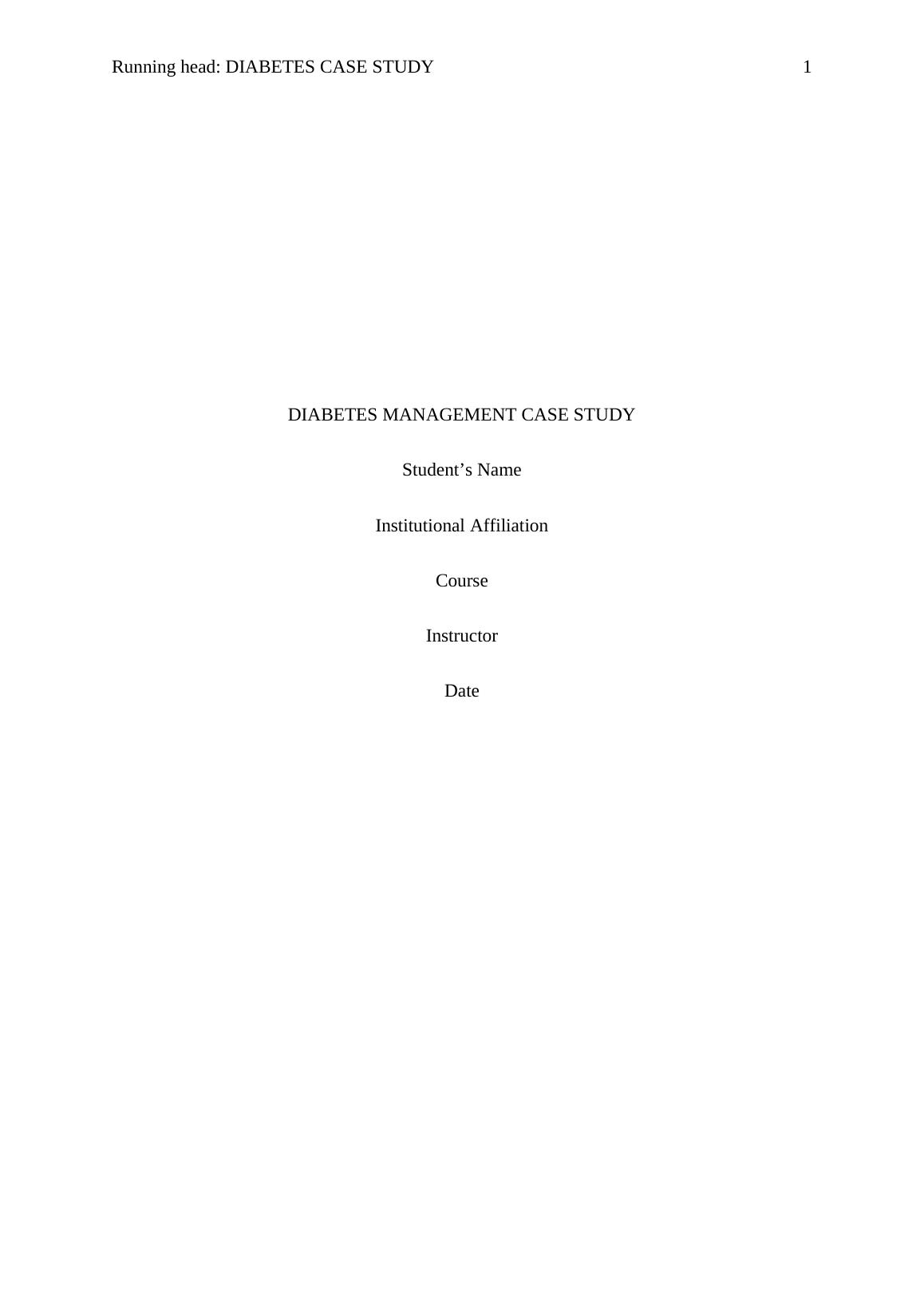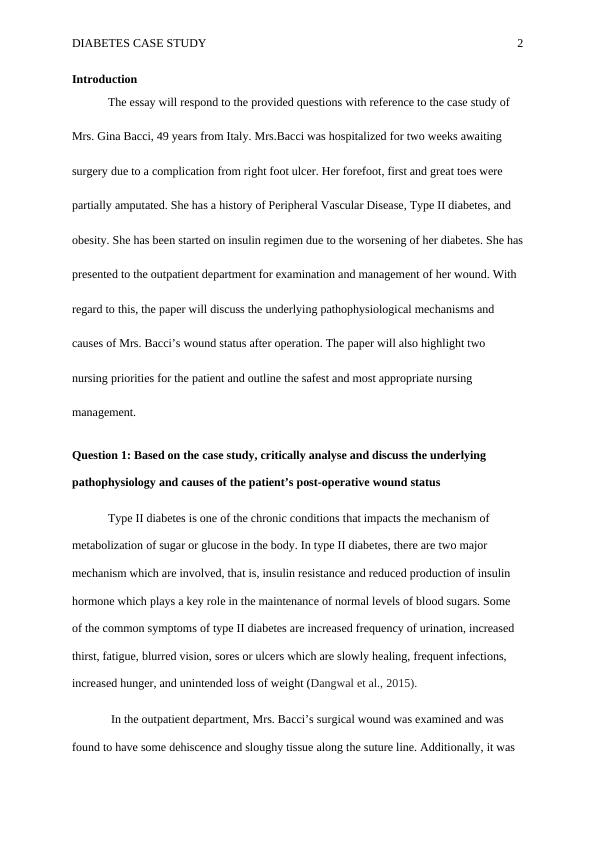Diabetes Management Case Study
Added on 2023-01-16
10 Pages3057 Words65 Views
Running head: DIABETES CASE STUDY 1
DIABETES MANAGEMENT CASE STUDY
Student’s Name
Institutional Affiliation
Course
Instructor
Date
DIABETES MANAGEMENT CASE STUDY
Student’s Name
Institutional Affiliation
Course
Instructor
Date

DIABETES CASE STUDY 2
Introduction
The essay will respond to the provided questions with reference to the case study of
Mrs. Gina Bacci, 49 years from Italy. Mrs.Bacci was hospitalized for two weeks awaiting
surgery due to a complication from right foot ulcer. Her forefoot, first and great toes were
partially amputated. She has a history of Peripheral Vascular Disease, Type II diabetes, and
obesity. She has been started on insulin regimen due to the worsening of her diabetes. She has
presented to the outpatient department for examination and management of her wound. With
regard to this, the paper will discuss the underlying pathophysiological mechanisms and
causes of Mrs. Bacci’s wound status after operation. The paper will also highlight two
nursing priorities for the patient and outline the safest and most appropriate nursing
management.
Question 1: Based on the case study, critically analyse and discuss the underlying
pathophysiology and causes of the patient’s post-operative wound status
Type II diabetes is one of the chronic conditions that impacts the mechanism of
metabolization of sugar or glucose in the body. In type II diabetes, there are two major
mechanism which are involved, that is, insulin resistance and reduced production of insulin
hormone which plays a key role in the maintenance of normal levels of blood sugars. Some
of the common symptoms of type II diabetes are increased frequency of urination, increased
thirst, fatigue, blurred vision, sores or ulcers which are slowly healing, frequent infections,
increased hunger, and unintended loss of weight (Dangwal et al., 2015).
In the outpatient department, Mrs. Bacci’s surgical wound was examined and was
found to have some dehiscence and sloughy tissue along the suture line. Additionally, it was
Introduction
The essay will respond to the provided questions with reference to the case study of
Mrs. Gina Bacci, 49 years from Italy. Mrs.Bacci was hospitalized for two weeks awaiting
surgery due to a complication from right foot ulcer. Her forefoot, first and great toes were
partially amputated. She has a history of Peripheral Vascular Disease, Type II diabetes, and
obesity. She has been started on insulin regimen due to the worsening of her diabetes. She has
presented to the outpatient department for examination and management of her wound. With
regard to this, the paper will discuss the underlying pathophysiological mechanisms and
causes of Mrs. Bacci’s wound status after operation. The paper will also highlight two
nursing priorities for the patient and outline the safest and most appropriate nursing
management.
Question 1: Based on the case study, critically analyse and discuss the underlying
pathophysiology and causes of the patient’s post-operative wound status
Type II diabetes is one of the chronic conditions that impacts the mechanism of
metabolization of sugar or glucose in the body. In type II diabetes, there are two major
mechanism which are involved, that is, insulin resistance and reduced production of insulin
hormone which plays a key role in the maintenance of normal levels of blood sugars. Some
of the common symptoms of type II diabetes are increased frequency of urination, increased
thirst, fatigue, blurred vision, sores or ulcers which are slowly healing, frequent infections,
increased hunger, and unintended loss of weight (Dangwal et al., 2015).
In the outpatient department, Mrs. Bacci’s surgical wound was examined and was
found to have some dehiscence and sloughy tissue along the suture line. Additionally, it was

DIABETES CASE STUDY 3
discovered that the surrounding area of the wound site was dark pink, painful to touch, and
warm. The presence of the infection and complication indicates poor progress of the process
of wound healing. Sometimes, the wound may end up not healing based on the medical
conditions of the patient, that is, type II diabetes, obesity, and Peripheral Vascular Disease
(Al-Goblan, Al-Alfi, & Khan, 2014).
Type II diabetes is a metabolic disorder that is long-term and is characterized by
elevated Blood Sugar Levels secondary to insulin resistance and relative lack of insulin.
Some of the manifestations of type ii diabetes are sores and ulcers which do not heal. With
regard to the case study, the patient developed a complication of right foot ulcer whose
surgical wounds seems to be hard to heal. Largely, insulin resistance is caused by physical
inactivity and obesity. In most instances, the diabetic wounds demonstrate slow healing
process due to various factors (Dangwal et al., 2015).
First, the high levels of blood sugar in type II diabetes contributes largely to poor or
delayed healing of the diabetic ulcers or wounds. Glucose in the body plays a crucial role in
one’s level of energy, the ability of the body to heal wounds or injuries, and the medical
needs of the patient. High levels of glucose in the body stiffens the blood vessels thus
interfering with the smooth flow of blood (DeFronzo, Eldor, & Abdul-Ghani, 2013). Reduced
blood circulation results in low supply of oxygen and nutrients which are required in the
repair of the surgical wound. Reduced oxygen supply in the area causes death of cells and
eventually tissue necrosis or amputation.
The second factor that contributes to the current status of the patient’ wound is
diabetic neuropathy which involves nerve damage due to high levels of blood sugar in the
body. Neuropathy results in numbness and tingling making it hard for the patient to feel the
injury. The third element which may have contributed to the poor healing of the diabetic
discovered that the surrounding area of the wound site was dark pink, painful to touch, and
warm. The presence of the infection and complication indicates poor progress of the process
of wound healing. Sometimes, the wound may end up not healing based on the medical
conditions of the patient, that is, type II diabetes, obesity, and Peripheral Vascular Disease
(Al-Goblan, Al-Alfi, & Khan, 2014).
Type II diabetes is a metabolic disorder that is long-term and is characterized by
elevated Blood Sugar Levels secondary to insulin resistance and relative lack of insulin.
Some of the manifestations of type ii diabetes are sores and ulcers which do not heal. With
regard to the case study, the patient developed a complication of right foot ulcer whose
surgical wounds seems to be hard to heal. Largely, insulin resistance is caused by physical
inactivity and obesity. In most instances, the diabetic wounds demonstrate slow healing
process due to various factors (Dangwal et al., 2015).
First, the high levels of blood sugar in type II diabetes contributes largely to poor or
delayed healing of the diabetic ulcers or wounds. Glucose in the body plays a crucial role in
one’s level of energy, the ability of the body to heal wounds or injuries, and the medical
needs of the patient. High levels of glucose in the body stiffens the blood vessels thus
interfering with the smooth flow of blood (DeFronzo, Eldor, & Abdul-Ghani, 2013). Reduced
blood circulation results in low supply of oxygen and nutrients which are required in the
repair of the surgical wound. Reduced oxygen supply in the area causes death of cells and
eventually tissue necrosis or amputation.
The second factor that contributes to the current status of the patient’ wound is
diabetic neuropathy which involves nerve damage due to high levels of blood sugar in the
body. Neuropathy results in numbness and tingling making it hard for the patient to feel the
injury. The third element which may have contributed to the poor healing of the diabetic

End of preview
Want to access all the pages? Upload your documents or become a member.
Related Documents
Pathophysiological Assessment and Nursing Care Priorities on Case Study Reviewlg...
|9
|2534
|342
Type II Diabetes: Pathophysiology, Causes, and Nursing Managementlg...
|11
|3177
|113
Nursing Assignment-Diabetic Case Studylg...
|10
|2911
|36
Diabetes Case Study: Analysis, Pathophysiology, and Nursing Managementlg...
|10
|2527
|2
Diabetic Foot Ulcer: Pathophysiology, Nursing Interventions, and Management Strategieslg...
|12
|2965
|24
Diabetic Case Scenario: Pathophysiology, Causes, and Nursing Managementlg...
|9
|2775
|91
